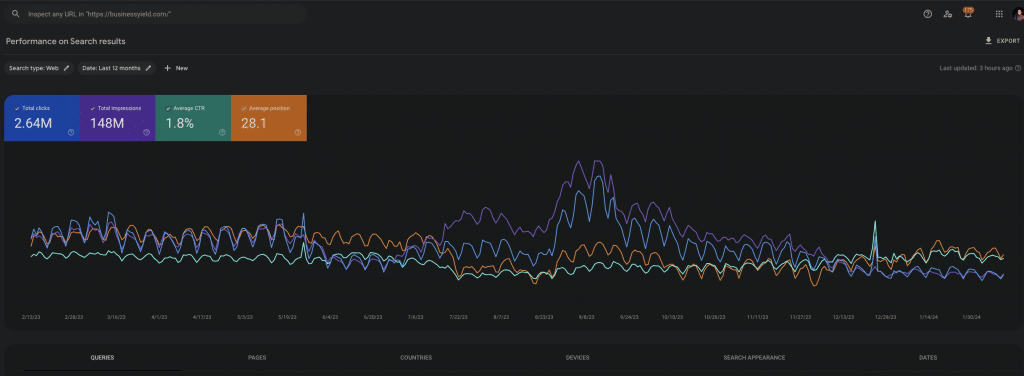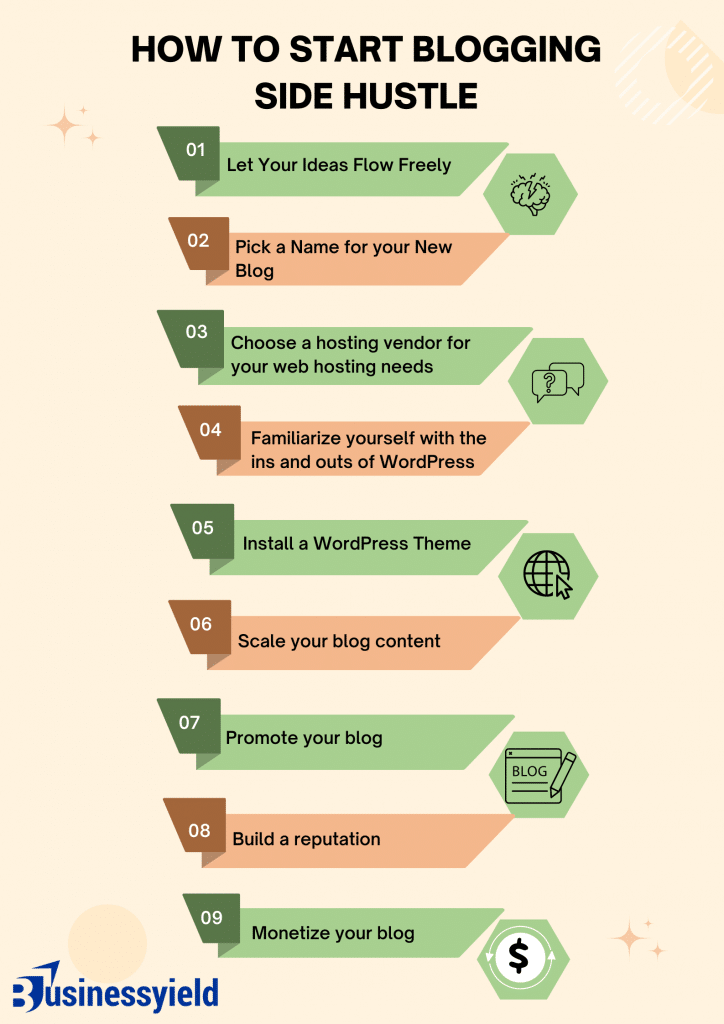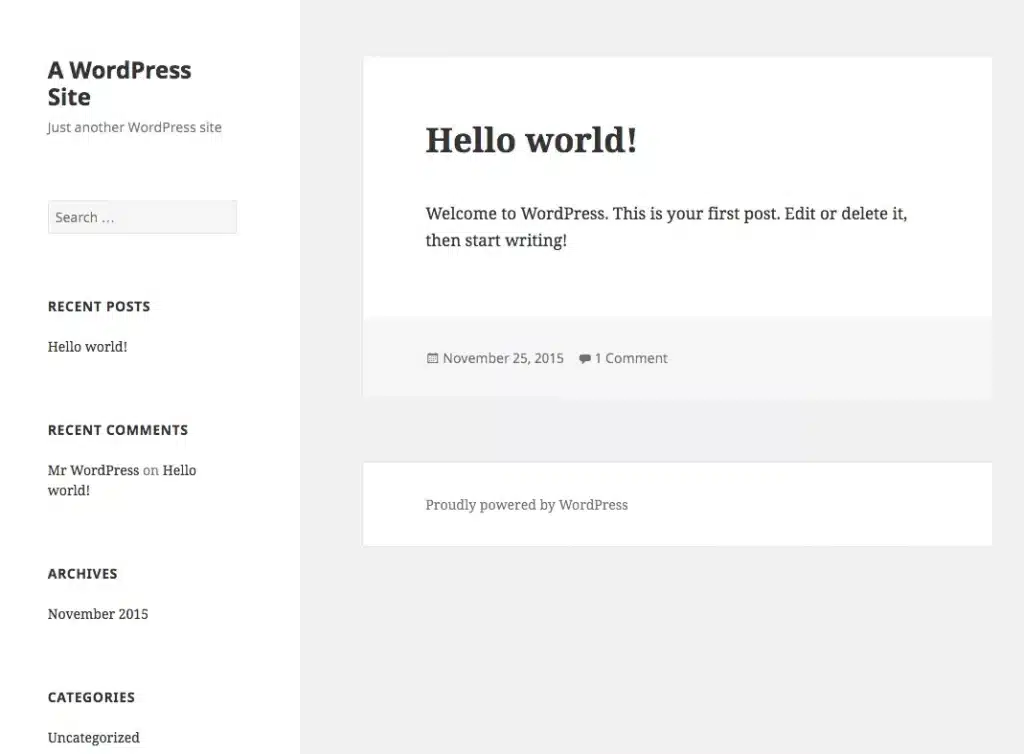Just about anyone has the potential to start a profitable blog as a side hustle; I kid you not.
And even though you’re starting as a side hustle, you can generate sufficient income from your blog to leave your current employment.
Need more convincing?
Aside from consulting and managing a handful of businesses offline, I also offer the same service for online businesses. One of the blogs I manage attracts a significant number of visitors each year and generates a substantial amount of revenue.
Here is a screenshot displaying the traffic volume statistics from one of them (name withheld).

This is an illustration of a 12-month performance from the previous year on Google alone. Traffic from Bing, Yandex, Yahoo, social media platforms, and so on is not included. The blog made more than $ 10,000 in a single month during that year!
Although it may not be feasible to achieve that level of income immediately, I can guide you on how to start a blog as a side hustle that generates at least $500 per month, for starters. This figure will increase as you scale up and implement the strategies in this article.
I started from scratch, just like you. I made tons of mistakes. But after years of experimentation, I discovered the key to running a profitable blogging platform as a side hustle and eventually turning it into a full-time income stream.
Following the blueprint outlined in this guide, you can avoid the mistakes I made and generate profits much quicker.
Disclaimer: Running a profitable blog that generates revenue as high as $10,000 to $70,000 (like a blog under my care is presently doing), you may need to fast-track the transition from side hustle to full-time hustle. It helps to give it all your attention.
Key Takeaways
- It’s feasible to transition from blogging as a side hustle to generating enough income to replace and even surpass one’s current employment earnings.
- Starting with a realistic income goal, such as generating at least $500 monthly from a blog, is achievable for beginners and scalable over time.
- The success in blogging is based on tried and tested strategies, emphasizing the importance of learning from those who have already succeeded.
- Blogging success is not static; initial achievements can be scaled up through strategic efforts, indicating the potential for growth in both audience and revenue.
- With the right approach and dedication, blogging can empower individuals to move beyond traditional job constraints, offering a path to financial independence and personal fulfillment.
Just in case you are not entirely sure what you are getting into, let’s start with the basics…
What is a Blog?
A blog, essentially a digital diary or instructional site, displays articles chronologically, ensuring the latest entries appear first. These entries can be penned by a single author or a collective of contributors.
Blogs vary widely, encompassing specialized (niche) blogs, professional company blogs, and individual personal blogs.
The primary goal of blogging is to forge a connection with its audience. Moreover, it is an effective tool for generating potential leads and increasing organic traffic to your website.
Blogging enables you to establish a brand presence and demonstrate your knowledge in your field. Whether pursued as a main occupation or a supplementary activity, blogging offers a versatile platform.
Let’s jump right into the steps I recommend you follow to start blogging as a side hustle.
How to Start Blogging Side Hustle (Expert Tips from My Blogging Journey)
These are the next steps you should take:
- Let your ideas flow freely
- Pick a Name for Your New Blog
- Choose a hosting vendor for your web hosting needs.
- Familiarize yourself with the ins and outs of WordPress.
- Install a WordPress Theme
- Scale your blog content
- Promote your blog
- Build a reputation
- Monetize your blog

Now let’s go over them one after the other:
Step 1: Let your ideas flow freely
There’s no need to feel overwhelmed about this whole thing. Take a deep breath. You can do it. Being successful doesn’t require you to overhaul the concept of blogging completely.
It’s important to provide clear details about the topic you’d like to discuss.
A great approach is finding inspiration from someone you admire in the same field or industry.
If they have a blog, give it a read. And then start allowing your ideas to take shape. For example, even with my experience and expertise in business consulting, I had to run a blog myself for a couple of months during my expansion. It was the only way to effectively manage my clients’ online and offline businesses. This meant I had to look for someone to look up to, and that person was Neil Patel.
His virtual guidance through YouTube videos, shorts, and blog articles has contributed to my success in blogging as a side hustle or full-time.
On the other hand, if you don’t have a particular person in mind, try finding someone you look up to. The goal is to ensure that you freely allow the ideas to come together.
When selecting your blog’s niche, it’s important to consider two essential questions.
#1. Am I interested in learning about this topic?
Your writing will reflect your passion for or lack of passion for the topic. If you don’t have a genuine passion for your blog’s topic, it’s best not to start one.
No matter what subject you choose, genuine passion and curiosity are important.
Otherwise, you’ll quickly exhaust your ideas. You risk losing any progress you made in the beginning.
Most importantly, you won’t be able to create content that will attract and engage your audience consistently.
If you’re feeling a bit confused, take a moment to consider the things that people often seek your advice on.
Are you often approached by friends or family seeking fitness advice? Do you have any suggestions for recipes? Are they looking for some career advice?
By considering these questions, you can easily identify your areas of expertise.
This worked for me when I started my first blog as a side hustle before including it in my business consulting services.
You may think you’re the only person in your 20s with a strong blogging passion. However, there are a handful of others like you.
Performing a brief Google search will yield over 1 million results tailored to individuals similar to yourself.
You may be curious if your idea is too unconventional or too general. But it would be beneficial to hone in on something that truly captivates your interest.
If you’re interested in starting a travel blog, avoid using generic terms like “travel.” Instead, opt for a more specific topic, such as “backpacking.”
Step 2: Pick a Name for Your New Blog
Let’s move on to the fun part: choosing a name for your blog.
This is your unique brand. It’s the impression that will stick with people.
Just keep it simple and straightforward. Building a brand’s magic takes time and effort. No matter the obstacles, just keep pushing ahead.
One effective approach to finding the ideal name is to begin by brainstorming. In the previous step, I mentioned the importance of expressing all your ideas and identifying your specific area of focus.
Now, let’s transform those ideas into a name.
You have two options: open a new spreadsheet or grab a pen and paper. Take a few moments to jot down any words that come to mind.
And then, start by combining words and phrases until you find something that catches your attention. Try coming up with 5–10 possible names and making a note of them.
Now, check if those names are available as domains. Your blog resides on a domain, which is its online home.
For example, the domain for Businessyield Consult is businessyield.com.
This is also the brand I write for every once in a while and you enter the address bar to locate this platform. However, you won’t be able to use the domain since it has already been bought.
After compiling your list, you can head to any domain name checker to check availability. Examples include Namecheap, Bluehost, Godaddy, and so on.
If you can’t find any available .com domain names you like, just go back to the start and continue brainstorming.
Here are a few additional suggestions to help you select a great domain name:
- It’s always best to go for a .com domain whenever you can.
- Avoid using numbers, hyphens, and homophones (words that sound the same but are spelled differently)
- Make it brief and to the point.
- It should be straightforward to pronounce and comprehend.
- Use words that are easy to understand and spell correctly.
- Before purchasing, it’s best to hold off on buying an available domain name.
Step 3: Choose a hosting vendor for your web hosting needs.
It’s time to make your blog live now.
Don’t fret, it may appear complex at first. It’s usually quite straightforward.
To begin, you’ll require web hosting, where your blog will be located, and a domain name, which will serve as your blog’s address.
If you want to make extra money from your blog in the future, you must think like an entrepreneur now. A web hosting service ensures the security of your data while also keeping your blog operational.
There are quite a number of options out there to pick from.
Our article on WEB HOSTING SITES: Best Web Hosting Services Of 2023 should help you make the best decision for your needs.
When selecting a hosting plan, consider factors such as fast site loading speed, good security, prompt customer support, and affordable prices.
After selecting a web hosting plan, you must register your domain name. Free domain registration is frequently included in Bluehost, InMotion, GoDaddy, and DreamHost web hosting packages.
Once you’ve completed that, the most challenging part is behind you! Congratulations on your new blog!
Step 4: Familiarize yourself with the ins and outs of WordPress
Beginners choose from the top blogging platforms, like Wix, Weebly, WordPress, and Joomla. What’s great is that all these platforms are free, saving you money on other expenses!
But for the purpose of this article, I will focus on WordPress because that’s what I use for every platform under my care.
Opting for a blog platform other than WordPress can result in higher expenses. WordPress provides a wide range of free plugins that enable you to customize your blog to your content.
Read Also: WHAT IS A CONTENT MANAGEMENT SYSTEM (CMS)
Most hosting platforms handle the WordPress installation for you during the setup process or after with a few clicks.
From there, you’ll see a button to Login to WordPress.
This will take you to your WordPress backend, where you’ll be able to add pages, make new blog posts, edit the look and feel of your site, install plugins, and more.
Take a little time to explore and familiarize yourself with the layout.
Step 5: Install a WordPress Theme
Themes are pre-built WordPress site designs.
By default, your WordPress blog will look like this:

Choosing a WordPress theme for your blog is where you begin. However, finding something that aligns well with your name, brand, and desired experience for your readers is important.
You have a wide variety of themes to choose from. But, it’s common to fall into the trap of “shiny object syndrome,” where you spend time browsing through numerous attractive pictures and templates without finding a theme that truly suits your requirements.
Feel free to change your theme whenever you want. Just pick something that suits your needs for now instead of worrying about finding the perfect choice. Similar to your brand, the theme of your WordPress blog is likely to develop over time as you discover what works and looks the most appealing in practice.
Exploring Themes on WordPress’ Website
By clicking on the theme’s thumbnail, you’ll be able to see a quick preview of how your blog will appear. See whether it aligns with your personal style and the subject you’ll discuss.
After you’ve checked out the sneak peek, just go ahead and click on the “Install” button.
After the installation is finished, just click on the “Activate” button, and you’re good to go.
If you’re having trouble finding a theme you like, below, I have put together some great premium theme providers where you can purchase themes:
- Themeforest
- Elegant Themes
- StudioPress
- Thrive Themes
At this point, your theme should be activated and all set to go. Now, we can proceed to personalize your theme.
Step 6: Scale your blog content
Now that you’ve decided where to host your blog and a theme to use, it’s time to plan, create, and publish high-quality content.
Before you start writing, you’ll need to create a content strategy to help your blog attract organic traffic and keep a consistent publishing schedule.
Your blog’s purpose and target audience will determine the types of posts you write.
Here are a few tips for researching blog topics:
#1. Conduct keyword research
Start by focusing on keywords, the words or phrases your target audience uses, and for which you want your blog to be known. This will help you appear higher in search engine rankings.
You can use Google Autocomplete, People Also Ask, and Related Searches to discover what people are searching for online about your main keywords.
Furthermore, you can also use free keyword research tools such as Answer the Public, Keyword Surfer, QuestionDB, Ubersuggest, or Google’s Keyword Planner to find high-volume keywords.
#2. Create topic clusters
This might feel like uncharted waters, especially for those hearing this for the first time. So, let me break it down. Topic clusters are organized around specific topics to help search engines find related content and increase search visibility.
How do you go about this?
Create a pillar page that covers a broad topic and focuses on a high-volume keyword. Then, use cluster pieces to target specific long-tail keywords.
Choose 5–10 pillar topics based on your blog’s core focus.
For example, if your pillar page is about productivity software, the cluster pieces might be:
What is the best free productivity app for Android users?
You could add an internal link from this cluster page to the pillar page using the anchor text “productivity app.”
If this still sounds confusing, I sourced a video from Hubspot’s YouTube page to help you get a hang of it.
#3. Research your competitors
Use Google to see who is already ranking for the keywords you’re looking for. Examine how your competitors have approached the topic and identify gaps you can fill with your content.
#4. Create a winning headline
You need to create attention-grabbing headlines to persuade people to read your posts. You can create free headlines using tools like HubSpot’s Blog Ideas Generator and The Hoth’s Blog Topic Headline Title Generator.
After completing your research, create an outline for your blog post to ensure you’ve covered all the important points. Draft the post, proofread it, and then publish it.
Another tip that has worked for me for years is posting regularly. This will help you attract organic traffic and show Google that you have an active blog.
Before taking big steps, create an editorial calendar to schedule when and how frequently you will publish content.
If this sounds like something you need help with, I have handpicked this video to help you stay on course and clear up any confusion.
Step 7: Promote your blog
Contrary to popular opinion, your work does not end when you hit the publish button. You must work to increase blog traffic. The more people visit your blog, the higher your income will be.
Here are a few ways you can promote your blog:
#1. Focus on SEO
While researching blog topics, your keyword research will help your blog become more visible in search engines.
Write in-depth posts that address common user questions and incorporate strategic long-tail keywords. This will allow your post to rank higher in organic search results. As a result, your blog will attract more visitors.
Use email marketing to keep your visitors coming back. Send a regular newsletter to promote your content and build a stronger relationship with your subscribers.
But how do you go about this?
Here is how I encourage my readers to subscribe to my newsletter on the platforms I manage or consult for:
- Create opt-in forms as pop-ups that invite visitors to sign up for your newsletter.
- Create lead magnets or free assets to encourage people to sign up for your newsletter. But what are lead magnets? Lead magnets are valuable assets that your target audience will appreciate. Examples include e-books, guides, online courses, and discount codes.
If you don’t use social media to promote your content, you’re missing out on a sizable chunk of readership. Create social media accounts for your blog on popular platforms such as Facebook, Instagram, YouTube, Twitter, and Pinterest.
Repurpose your blog content into the preferred formats of these platforms, such as videos for YouTube and infographics for Instagram. Link back to your blog to increase traffic from these platforms.
Step 8: Build a reputation
To build a reputation, you’d have to consciously increase your online presence and establish yourself as an authority in your field to attract more visitors to your blog.
You can write guest posts for reputable websites such as Entrepreneur, Inc. and Fast Company. Alternatively, you can follow prominent bloggers in your field to see where they have guest posts published.
Guest blogging allows you to build backlinks to your blog. This improves your SEO and increases your blog’s visibility in search results.
Step 9: Monetize your blog
When you have a large following and a solid content strategy, it’s time to start making money from your blog.
There are several ways I make money from the blogs I manage:
#1. Sell ad space
Place targeted ads on your blog to earn money using Google AdSense. Simply put, you are paid when the advertisements are viewed or clicked. As a result, you can generate revenue from your blog traffic.
You can customize the ads’ size, shape, and placement to provide a pleasant browsing experience for your visitors. For a consistent visual experience, use ad colors that match your blog’s color palette. Here are a couple of tools you can I use to personalize the look of your ads, you can try them too:
- Creatopy
- Venngage
#2. Use affiliate marketing
An affiliate program allows you to earn commissions by promoting the products or services of others. You include affiliate links to products or services in your posts, blogs, or social media pages. When visitors click on the links and make a purchase, you earn a commission.
However, remember to disclose that you’ve included affiliate links in your blog.
Popular affiliate programs include Amazon Associates, Awin, CJ Affiliate, and ShareASale.
#3. Sell digital products
Bloggers with subject matter expertise can supplement their blog income by selling digital products such as e-books, online courses, video guides, or webinars.
Digital products have low overhead and no shipping costs, allowing you to price them lower than physical products.
#4. Offer paid subscriptions or memberships
Paid memberships to your blog can include benefits such as a private community for idea exchange, access to webinars, free consultations, and unlimited downloads of your infoproducts.
You can also provide in-depth content with unique insights to paid subscribers. To entice readers to subscribe, provide a preview of the content and invite them to purchase a subscription to read the entire piece.
#5. Write sponsored content
After you’ve established an online presence, companies may approach you about brand collaborations, in which you write a paid post promoting their products or services. You may also be offered free products as an added benefit.
Select your sponsors carefully to ensure that your credibility remains intact. Thoroughly research the products and services you recommend to your target audience.
You can also contact brands you want to work with to inquire about collaboration opportunities.
How do I make my blog popular?
Choosing a niche topic for your blog is the first thing you need to do to make it successful. Find out what other blogs are already out there; you don’t want yours to be in a niche that’s already full of blogs that are like yours. You should also try to choose a topic that is related to ways to make money with your blog, such as affiliate links, sponsored posts, or partnerships. After that, choose a CMS (like WordPress), set up your site, write and publish your first post, and then make sure you post regularly.
What are some CMS that can be used on a blog?
E-commerce sites can use WordPress, Wix, or Shopify. When you’re looking for a CMS, make sure it’s easy to use, has cross-channel publishing, can be expanded, and works with other systems.
What should I call my blog?
There are free tools that can help you come up with names. Use these to make sure that the name you want doesn’t already belong to someone else.
How do I make my blog search engine friendly (SEO)?
Configure Google Search Console and Bing Webmaster Tools, make sure your XML sitemap is set up correctly (Yoast can do this for you), and set up permalinks. If you’re using WordPress, use a trusted SEO plugin like Yoast.
What kind of money do successful bloggers make?
Bloggers who do well can make up to $700,000 a year by 2020. But those are only the best bloggers in very successful and well-known fields, like parenting or marketing.
How long do you think it will take for my blog to start making money?
You might be able to make money from your blog as soon as six months after you start it. This will depend on how well you can use SEO, affiliate links, and write about well-known topics.
In Conclusion
It’s easy to start a blog. But it takes a lot of hard work and dedication to make a blog that makes money.
Remember to be patient as you start your blog. You won’t make multiple hundred or thousand dollars in one day.
Blogs are cheap to run, and it won’t be long before you make enough to cover their costs.
You can quickly make more than $3,000 a month from your blog if you follow my steps, tips, and best practices.
Here is everything you need to get going. You can start right away by signing up for Bluehost and getting a free domain name and web hosting.
When you first start blogging, keep in mind that you’re writing for people.
Be yourself. Try new things. Being honest and open is key.
As long as you keep making great content, your tribe will show up, listen, and buy from you.
- SIDE HUSTLE IDEAS 2023: Top Side Hustle Ideas to Make Extra Money in 2023
- SIDE JOBS FROM HOME: Best & Flexible Jobs From Home 2023
- JOBS FOR MEN: 20+ High-Paying Side Jobs for Men in 2023
- Best 2023 ONLINE SIDE HUSTLES to Make Money, Revealed!!! (+ Free Tips)
- The 9 Best Side Hustles to Start Right From the Comfort of Your Own Home






